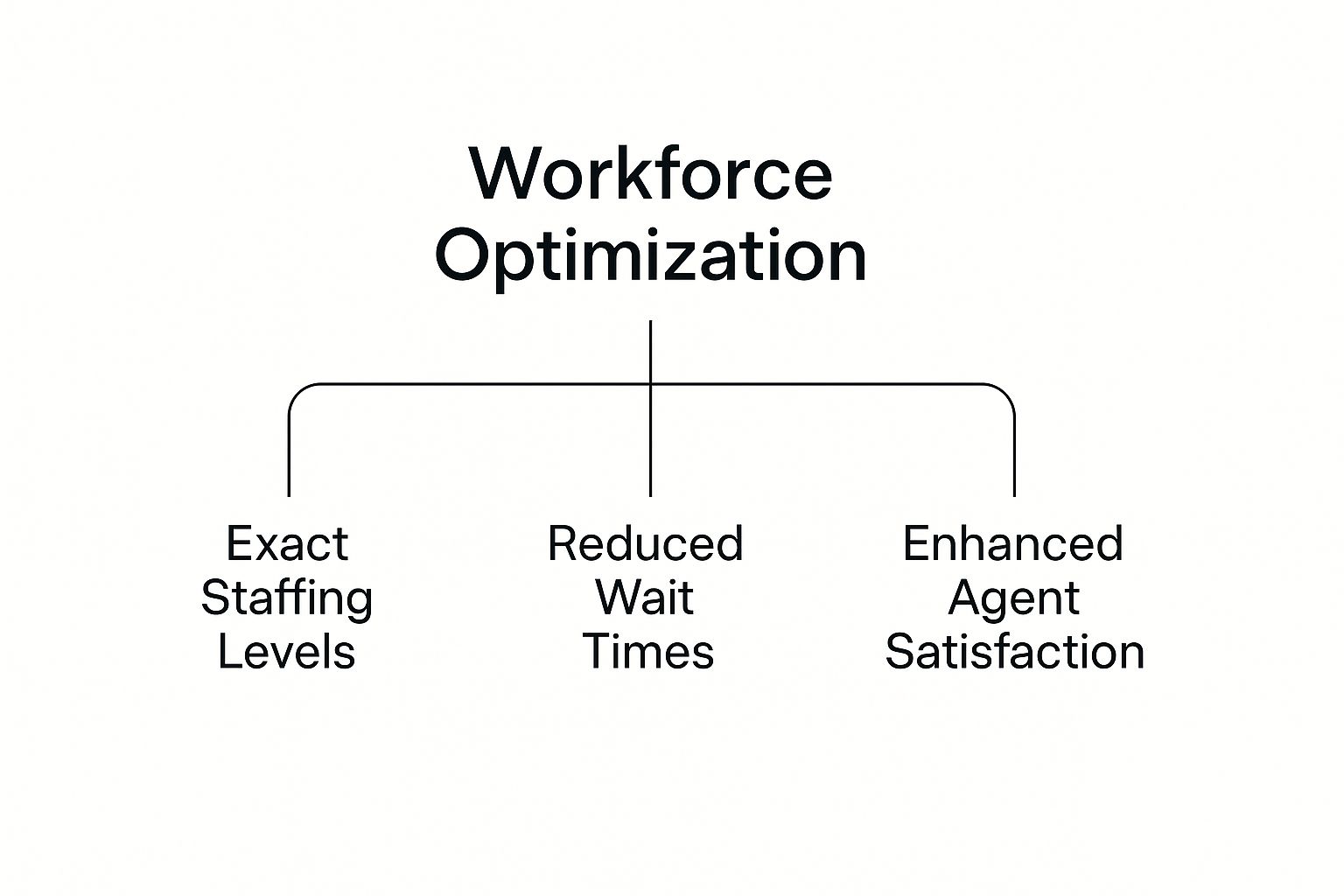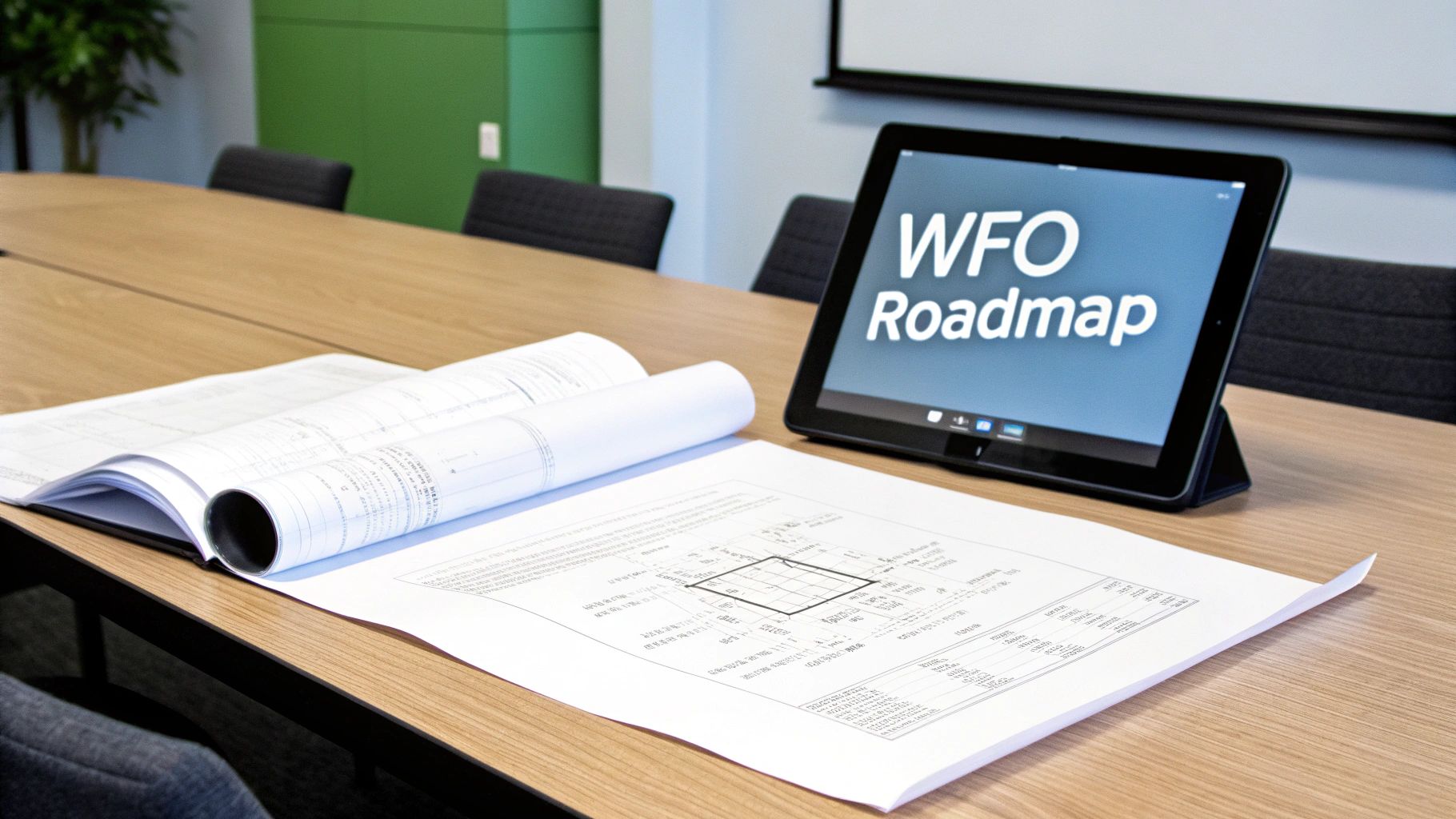Call center workforce optimization, or WFO, is really just a fancy way of describing a strategy to get your staffing just right. It’s all about using data, smart tools, and solid processes to strike that perfect balance between keeping your operations efficient, your customers happy, and your agents sane.
Think of it as the ultimate goal: having exactly the right number of skilled agents ready to go when your customers need them. No more, no less. This approach is designed to squeeze every bit of performance out of your operations while keeping costs in check.
Imagine your call center is a symphony orchestra. In this scenario, workforce optimization is the conductor. It’s their job to make sure every musician (your agent) is in the right place, with the right skills, playing the right notes, at precisely the right time.
It's not just a single piece of software; it's a complete business strategy. The whole point is to align your staffing levels and agent talents perfectly with customer demand. Done right, you eliminate both wasteful overstaffing and the frustrating understaffing that leads to angry customers sitting in long queues.
That delicate balance is where the magic happens. When you nail it, WFO creates a ridiculously efficient operation that delivers a fantastic customer experience without burning out your team.
This diagram shows how getting your staffing numbers right is the foundation for achieving all those other key operational goals.

As you can see, optimizing your workforce isn't just about shaving a few dollars off the budget. It's a direct line to happier agents and, in turn, more satisfied customers.
This field has changed dramatically in recent years, mostly thanks to the rise of AI-powered tools. These modern systems are bringing a new level of efficiency, helping with agent retention, and making forecasting more accurate than ever.
The shift is undeniable. Recent industry analysis shows that nearly 99% of contact center leaders now view workforce management as critical to their success. On top of that, 81% say its importance is only growing.
The success of any modern WFO strategy relies on four core pillars. Each one addresses a different part of the operational puzzle, but they all work together to create a smooth, efficient system.
Here's a quick look at those foundational components.
Core Pillars of Workforce Optimization
Getting these four pillars right is what separates a world-class call center from one that’s constantly putting out fires.
To put these strategies into action, it helps to explore the various top workforce management solutions available. These tools can give you valuable insights and the technological muscle to drive real success.
By integrating intelligent software, you can achieve a level of precision and agility that simply wasn't possible before. This is how you move your call center from a reactive model to a proactive, data-driven powerhouse.

A solid call center workforce optimization strategy doesn't just materialize out of thin air. It’s carefully constructed on four interconnected pillars. Each one supports the others to create an operation that’s resilient, efficient, and balanced. If one pillar is shaky, the whole structure is at risk of crumbling under pressure.
Think of these pillars like the supports holding up a massive bridge. Each one needs to be strong and perfectly aligned to handle the constant flow of traffic—or in this case, a steady stream of customer interactions.
It all starts with the first pillar: forecasting and budgeting. This is where you look into your crystal ball—backed by data, of course—to predict customer demand as accurately as possible. The goal is to answer one critical question: "How many agents will we need, and when will we need them?"
In the old days, this meant digging through past call logs and making an educated guess. Today's AI-powered forecasting tools can predict call volumes and help allocate staff in real time, preventing you from being caught understaffed or wasting money on idle agents. This is a game-changer, especially when 61% of contact centers say volatile contact volumes are their biggest challenge.
Getting this pillar right gives you a data-driven blueprint, saving you from burning cash on overstaffing or losing customers to frustratingly long wait times.
Once you have a handle on demand, you move to the next pillar: intelligent scheduling. This is so much more than just dropping names into a spreadsheet to cover shifts. Modern scheduling is a dynamic puzzle, fitting together agent availability, specific skills, and even personal preferences to hit your service targets.
A truly intelligent scheduling system juggles multiple variables at once:
This approach creates schedules that not only make sense for the business but are also fair and even desirable for your agents. That's how you build an engaged and stable team.
The third pillar is all about thinking on your feet. Real-time adherence and management is the art of making live adjustments when things inevitably go off-plan. No forecast is ever 100% perfect. A viral marketing post or a sudden service outage can send call volumes through the roof, and that’s when real-time management becomes your best friend.
A great plan is useless without the ability to adapt. Real-time adherence ensures that your carefully crafted schedules are actually being followed and gives managers the power to react intelligently to unforeseen challenges, protecting service levels and the customer experience.
Supervisors keep an eye on live dashboards, watching queue lengths and agent statuses. If wait times start to creep up, they can instantly deploy backup agents, approve overtime, or pull people from less critical tasks to jump on the phones and manage the surge.
Finally, the fourth pillar closes the loop: performance analytics. This is where you collect and dissect data from every single interaction to uncover powerful insights. It's how you measure what’s working, pinpoint what isn't, and continuously fine-tune your entire WFO strategy.
To truly optimize, you have to define and track the metrics that matter, like the critical customer service performance indicators that directly show how effective your WFO efforts are. This pillar helps you understand not just what happened but why it happened, giving you the intelligence you need to improve everything from agent coaching sessions to your forecasting models for the next quarter.
Let's be honest. The old way of managing call center staff—relying on gut feelings and tangled spreadsheets—just doesn't fly anymore. In today's world, a solid call center workforce optimization strategy has gone from a "nice-to-have" for massive corporations to a must-have for survival and growth.
This isn't just about shaving off a few percentage points on efficiency reports. It's a fundamental business shift with a return on investment you can actually see and measure.
Think of it this way: every minute an agent is sitting idle from overstaffing, your business is leaking money. On the flip side, every minute a customer waits in a queue because you're understaffed, your reputation takes a hit. WFO tackles both problems head-on, perfectly aligning your staffing with actual demand.
The financial impact is immediate. By getting rid of wasteful overstaffing, companies can dramatically cut down their operational costs. It’s simple, really. If your data shows you only need 15 agents on a Tuesday morning but you’ve always scheduled 20, WFO software shines a bright light on that inefficiency.
This data-first approach means your budget gets put to work where it has the most impact.
But it’s not just about the bottom line. WFO has a direct and powerful effect on the customer experience. When your staffing levels actually match your call volume, wait times shrink. Shorter queues mean faster answers, which naturally leads to higher customer satisfaction (CSAT) scores.
Happy customers don't just happen by accident. They are the direct result of a well-oiled operation where their time is respected and their issues are resolved quickly—a core promise of workforce optimization.
That connection is everything. A single great experience can turn a one-time buyer into a loyal fan for life, proving that operational smarts and customer loyalty are two sides of the same coin.
Maybe the most important reason WFO is non-negotiable comes down to your most valuable asset: your people. Call centers are notorious for agent burnout and high turnover rates, and that churn is incredibly expensive. A smart call center workforce optimization plan is one of your best defenses against it.
WFO tools bring fairness, transparency, and flexibility to scheduling. Instead of rigid, top-down schedules that nobody likes, agents can often bid on shifts or easily swap hours. This gives them a real sense of control over their lives and makes for a much better work-life balance.
This empowerment creates a ripple effect of positive outcomes:
When you start looking at WFO as a strategic investment in your team, you end up building a more stable, engaged, and productive workforce. And that’s the real engine that powers sustainable growth.

If you think of traditional WFO as using a map and compass, then AI is like handing your team a real-time GPS. It doesn't just show the best route; it predicts traffic jams and reroutes you on the fly.
Artificial intelligence is the engine behind this massive shift in call center workforce optimization. These sophisticated tools are doing much more than just managing tasks. They’re fundamentally changing how call centers operate by supercharging human talent, freeing up leaders to focus on what really moves the needle: coaching and developing their people.
Let's get one thing straight: AI isn't here to replace your agents. It's here to make them exceptionally better at their jobs. The goal is to build a powerful partnership between human and machine, where intelligent tools handle the heavy lifting and administrative grind. This lets your team focus on the high-value, emotionally complex conversations where they truly shine.
Here’s how it works in practice:
This symbiotic relationship leads to faster resolutions, more consistent customer experiences, and a team that feels supported instead of bogged down. It’s all about making your people smarter, faster, and more effective.
Perhaps the biggest game-changer is how AI helps us understand and react to customer emotions. Sentiment analysis is quickly becoming a standard part of the WFO toolkit, giving managers a live pulse on the emotional state of every interaction.
By analyzing tone of voice and word choice, AI can instantly flag a call where a customer is getting frustrated. This gives a supervisor the chance to jump in and help, turning a potentially negative experience into a positive one before it ever escalates.
This isn't some far-off future tech; it's happening now. It’s expected that by 2025, nearly 95% of all customer interactions will be processed using sentiment analysis. This reflects a massive industry trend where 98% of contact centers will have AI integrated into their operations. You can dig into more data on this shift by checking out these call center statistics from Sprinklr.
By understanding customer emotions as they happen, agents can adapt their approach in real-time, leading directly to better outcomes and much higher satisfaction rates.
Bringing a powerful workforce optimization strategy into your call center is a big deal. It’s way more than just plugging in some new software—it’s a fundamental shift in how your team operates. If you want to get it right, you need to look past the tech and anticipate the human-sized hurdles that can trip up even the best-laid plans.
The first, and arguably biggest, roadblock is often agent resistance. If your team sees these new tools as a "Big Brother" system designed to micromanage them, you’re in for a rough time. The secret is to frame the change around what’s in it for them, not just what’s in it for the company.
To win your team over, you have to connect the dots between the WFO platform and their day-to-day work lives. This isn’t about squeezing out more efficiency; it’s about making their jobs better and fairer.
Shine a spotlight on these agent-first benefits:
When your agents start seeing the WFO system as a tool that supports their growth and well-being, they’ll turn from skeptics into your biggest champions. That mind-shift is absolutely essential for a smooth rollout.
Another major headache is getting all your different technologies to talk to each other. Your WFO platform can't do its job in a silo. It needs a steady stream of data from your other critical systems to make accurate predictions and provide useful real-time insights. Think about it—connecting your WFO software with your CRM isn't optional; it's the only way to get a complete picture of your operation.
A disconnected WFO system is like a conductor trying to lead an orchestra without being able to see half the musicians. To create harmony, every data source must be integrated and visible, providing a single source of truth for decision-making.
Finally, you need to get your agents ready for a new reality. As automation and AI start handling the simple, repetitive questions, your human agents are left with the tough stuff—the complex, emotionally-charged conversations. In fact, a whopping 61% of leaders say customer interactions have gotten more difficult as AI handles the easy queries. This trend, highlighted in Zoom's recent call center statistics, means your agents need a stronger toolkit of soft skills.
This isn't something you can leave to chance. It requires a real commitment to upskilling and continuous training in areas like active listening, de-escalation, and emotional intelligence to help your team handle these high-stakes interactions with confidence.

Alright, let's get down to brass tacks. Moving to a fully optimized workforce isn't something that just happens. You need a clear, actionable game plan to get from strategy to reality. This four-step plan is your blueprint for rolling out call center workforce optimization the right way, from the first assessment to ongoing fine-tuning.
Think of it like building a house. You wouldn’t just start throwing up walls without a solid foundation and architectural plans, right? This process ensures your WFO initiative is built to last.
Before you can map out where you're going, you have to know exactly where you are. The first move is a no-nonsense audit of your current operations. What's actually working, and where are the cracks showing?
This is where you gather your baseline data. Document your core KPIs—things like average handle time, first-call resolution, and agent adherence rates. Get honest about your biggest headaches. Are you constantly blindsided by unexpected call volumes? Is agent churn eating away at your budget? This initial assessment becomes the yardstick you'll use to measure all future success.
Armed with a clear picture of your needs, you can now pick the right tools for the job. Not all WFO software is built the same, so you need to focus on platforms that solve your specific problems. Look for a solution with powerful forecasting algorithms, flexible scheduling options, and insightful real-time analytics.
One thing you can't overlook is integration. Your WFO tool absolutely must connect smoothly with your existing CRM and contact center platform. If it doesn't, you'll end up with data silos, which is a nightmare for decision-making. A clean integration creates a single source of truth for all your operational data.
Choosing the right WFO software isn't just about ticking boxes on a feature list. It's about finding a solution that fits your specific needs and can grow with you. To help you evaluate your options, here’s a checklist of what to look for.
Think of this table as your shopping guide. The right platform will feel less like a piece of tech and more like a strategic partner in your success.
A successful WFO implementation hinges on finding software that not only meets your technical requirements but also aligns with your operational goals. The right platform acts as a force multiplier for your strategy, not just another piece of tech.
Now, we get to the most important part: the people. Dropping a new system on your team without a plan is a recipe for disaster. You need smart change management to get everyone on board, from managers to frontline agents.
Create a clear communication plan that sells the benefits. We're talking fairness, flexibility, and opportunities for growth—not just corporate-speak. Back it up with solid training that makes your team feel confident with the new tools. A great tactic is to start with a small pilot group. This lets you iron out the wrinkles before the full-scale launch, minimizing disruption and building positive momentum.
Workforce optimization isn’t a "set it and forget it" project. It's a continuous loop of improvement. Once you're live, put those analytics tools to work. Track your KPIs and measure how far you’ve come from that initial baseline.
Constantly dig into the performance data to spot trends and find new ways to refine your approach. Celebrate the wins with your team—it keeps everyone engaged. Use the insights you gather to make data-driven tweaks. This iterative process ensures your call center workforce optimization strategy stays sharp and keeps delivering value as your business grows.
Jumping into the world of call center workforce optimization can definitely spark a few questions. Let's tackle some of the most common ones we hear from leaders looking to get it right.
It’s easy to get these two mixed up, but the distinction is pretty simple when you break it down.
Think of Workforce Management (WFM) as the logistics mastermind. It’s all about forecasting call volumes and creating schedules to match. WFM is focused on having the right number of agents in the right seats at the right time.
Workforce Optimization (WFO), on the other hand, is the entire strategy. It includes WFM as a core component but adds other critical layers like quality management, performance analytics, and even agent coaching. WFO asks the bigger questions: Are these agents performing well? Do they have the skills they need? How can we make them better?
So, while WFM handles the headcount, WFO makes sure that headcount is skilled, motivated, and delivering exceptional service.
Absolutely. It's a common misconception that WFO is only for massive, enterprise-level operations. In reality, smaller teams often see some of the biggest gains.
For a small call center, every agent's performance counts that much more. WFO provides the tools to maximize each person's potential, cut down on wasteful spending from overstaffing, and boost the quality of your service without blowing your budget. It effectively levels the playing field, helping a small team operate with the precision and efficiency of a much larger competitor.
Workforce optimization isn’t just for enterprise-level operations. It's a strategy that scales, delivering tangible benefits in cost savings, agent satisfaction, and customer experience for call centers of any size.
The return on your investment in WFO can show up faster than you might think. Many call centers start noticing the first positive changes within a few months.
The first wave of benefits usually comes from cost savings. You’ll see more accurate scheduling immediately cut down on unnecessary overtime pay. Right after that, you'll start to see improvements in agent productivity and those all-important customer satisfaction scores as your whole operation becomes smoother and more data-driven.
Ready to streamline your business communications and capture every lead? My AI Front Desk offers an AI receptionist and outbound dialer designed to help small businesses grow. See how our AI solutions can transform your front desk at https://myaifrontdesk.com.
Start your free trial for My AI Front Desk today, it takes minutes to setup!








